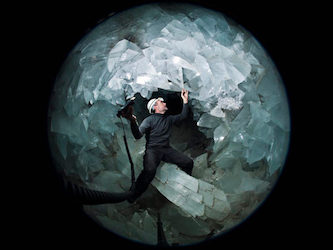One of the largest geodes in the world, the Pulpí geode, was discovered in 1999. It is deep within a mine in Spain. It is a hollow, egg-shaped object, like those in rock shops. But it’s 36 feet wide, like a room with crystal-paneled walls. Individual crystals are up to two meters in size, and are so transparent they look like ice crystals. A study published October 15, 2019, in the peer-reviewed journal Geology proposed that a slow and steady process involving temperature fluctuations grew the giant gypsum crystals inside. Juan Manuel García Ruiz is a professor at the Universidad de Granada in Spain and a study coauthor. He said at Phys.org:
Unlike the giant crystals of Naica in Mexico where the hydrothermal system is still active, the large geode of Pulpí is a fossilized environment.
The large crystals trapped a few fluid inclusions, which gave scientists information about conditions at the time the crystals formed. The team measured the sulfur and oxygen isotope ratios of the inclusions and found that the gypsum likely stabilized at a temperature of about 68 degrees Fahrenheit.
Most areas that have grown giant gypsum crystals are attached to inactive hydrothermal systems. The fact that the crystals stabilized at 68 F degrees suggested they may have formed closer to Earth’s surface, where climate fluctuations may have played a role. T
Scientists suggested that the crystals had grown over a long period of time from a slow, steady drip of a concentrated calcium sulfate solution. An article in EOS explained: With a relatively stable temperature, many smaller gypsum crystals dissolved to form fewer, larger ones in a process called Ostwald ripening.

